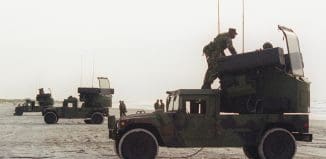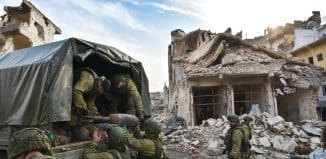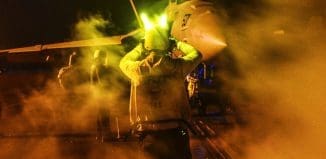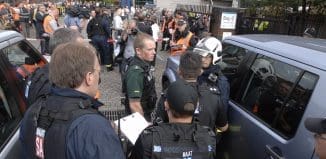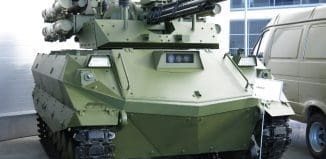Gas Masks: Toward the End of the Line?
This post is also available in:  עברית (Hebrew)
עברית (Hebrew)
By Meir Elran and David Friedman
The emerging proposition in the Israeli defense establishment, reported recently in the media, to shut down the gas masks project to protect the country’s civilians on the home front is a yet another manifestation of the fluctuations that have characterized Israeli policy in this critical area.

Only two months have passed since public and media pressure caused anxiety at the mask distribution centers in Israel, following the US threat to employ force against Syria after the regime’s August 21, 2103 chemical weapons attack against the rebels. There was also a suggestion, originating from the National Security Council, to place the financial burden of purchasing the masks that were lacking, some 40 percent, directly on the public. The extent to which Syria is in fact destroying its extensive arsenal of chemical weapons is still not clear, nor are its intentions regarding the production capabilities. Under such circumstances, is the new idea of closing the program, on which billions of shekels of taxpayer money have been spent, correct?
The project to distribute gas masks for personal protection against chemical weapons started in connection with the perceived Iraqi threat. The decision was made in 1990, on the eve of the 1991 Gulf War. Although the Iraqi threat never materialized, the IDF Home Front Command maintained the project until 2003, when the decision was taken by the government to collect the gas masks from the public, which took place in 2007-2008. Two years later, upon the recommendation of the Home Front Command, the government decided to resume the gas masks distribution, despite reservations from, among others, IDF quarters. However, the funding provided for the renewed project was far less than needed. This has never changed, creating an odd situation in which there has been a constant gap between supply and demand, with masks unavailable to more than one third of the Israeli public – even those who wished to respond to the ongoing pleas of the Home Front Command to acquire the masks.
From the outset the gas mask chapter has been accompanied by sharp controversy within the defense establishment and the public at large. On the one hand, there is the natural tendency – some would say critical need – to provide optimal protection to the general public against a threat that has been presented as real, even if most of its impact is psychological in nature. Technologically, the gas masks indeed provide a high quality, simple solution for the consumers, even in a biological attack scenario. The chemical threat has always been perceived in the civil defense system as a primary risk component and has prompted serious and meticulous response steps in many fields, including the medical system. Numerous and frequent exercises have also been held in a chemical attack environment, to sustain a high rate of Israeli preparedness.
On the other hand, there are those who repeatedly argue that although Syria possesses large quantities of chemical weapons, and despite the history of Arab states (Egypt, Iraq) that have used such weapons in conflict situations, as well as the unconfirmed reports about the spillover of chemical weapons to terrorist organizations, the chances that this weapon will be used against Israel are slim and have never created a real risk that made this broad and very expensive civilian project necessary. The main argument in this context is that Israel’s deterrent capability will be sufficient, particularly as there is arguably no precedent to using chemical weapons against an enemy that has the ability to launch a tough and painful response. The budget was always at the center of this ongoing debate, because of the very high cost involved. Estimates suggest that it would now cost some 1.4 billion shekels just to complete the production and distribution of gas masks to the entire population, with an additional 300 million shekels a year over twenty-five years required to maintain the masks and replace those that have worn out.
IHLS – Israel Homeland Security
Discussion on a different, more professional level, namely, the issue of emergency preparedness, should focus on the strategic priorities for building the right and balanced response to the needs of the home front in Israel. Like many other countries that engage with protecting the homeland and deal with mass disaster preparedness, Israel has a clear tendency to invest most of its resources in resistance and prevention. Over the years, Israel has invested in deterrence and offensive capabilities, based on the correct assumption that those will contribute to at least postponing the next conflict. On the second level there are the growing expenditures on defensive measures, and in particular, acquisition of “hard” systems of protection. Here, for example, are the extensive procurement of active defense systems such, as the Iron Dome and the components of passive protection, such as the gas masks and the public and private shelters. In this context too there is an ongoing debate about the scope of expenditure required. There are those who believe it is not appropriate “to protect ourselves to death” (in the words of former Prime Minister Ehud Olmert) and hence the tendency to limit the spending to the extent possible. Others, like the current Home Front Defense Minister Gilad Erdan, hold that the gaps in passive protection are not acceptable and call for additional funding. Investments in the realm of resilience, which address the consequences of disruptions on the “day after” and the fast recovery of functional continuity and rehabilitation, are regarded only as a distant third priority.
In conclusion, we suggest that:
- The idea of reexamining the issue of gas masks is correct and necessary, given the developments in connection with Syria’s apparent new policy on chemical weapons. This will require a careful study of Syria’s residual capabilities and Hizbollah’s future potential. In terms of timing, it would be appropriate to wait until it is clearly proven that Syria has in fact destroyed its chemical weapons arsenal, including the production capabilities.
- The adequate alternative strategy for a possible renewed military chemical threat in the future is a combination of active deterrence, close intelligence monitoring, and destruction of a new arsenal upon its establishment, or at the start of the fighting.
- If a decision is made to cancel the gas mask project, it is recommended to transfer the funds still to be spent on it to other areas connected with the preparedness of the civilian front. We recommend that these funds be used primarily for developing community resilience, in order to strengthen the ability of communities and systems that may be damaged in the future to recover and return quickly to improved functional continuity.
- Finally, this episode also indicates unwarranted confusion regarding the primary issue of responsibility and authority in the sensitive field of the civilian front. It would be right for the government to make a clear decision promptly on the question of who is responsible for this critical area and what the role of the defense minister is in the decision making process and in setting the priorities.
INSS Insight No. 487, November 24, 2013






